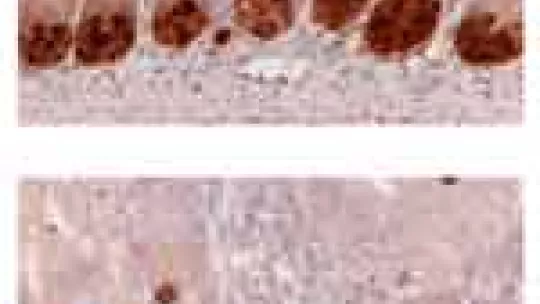Images
Researchers at IRB Barcelona describe the molecular mechanisms that define distinct territories in the intestinal epithelium.
These molecular mechanisms could be highly relevant in the development of malignant tumors.
How do cells know where to position themselves and where to accumulate in order to carry out their functions correctly within each organ? Researchers with the Colorectal Cancer Lab at IRB Barcelona have revealed the molecular mechanisms responsible for organizing the intestinal epithelium into distinct comportments, defined by frontiers or territories. The study, headed by Eduard Batlle, coordinator of the Oncology Programme at IRB Barcelona and ICREA Research Professor, is published in today’s online version of the Journal Nature Cell Biology, part of the prestigious editorial group Nature.
The organization of tissues and organs in the human body can be compared to a very complex and sophisticated engine, whose structure is maintained by positioning its components (cells) in a very precise way. Errors in the assembly (location) of the components might lead to changes in the function of the engine (tissue or organ).
New protein complexes that position cells in the right place
Complex tissues and organs require the separation of diverse cells types into separate zones in order to maintain their architecture. In the case of the intestinal epithelium, the lower part of the invaginations formed by the epithelium, called crypts, contains stem cells that regenerate tissue, while the upper part holds differentiated cells that are responsible for nutrient absorption.
The so-called EphB receptors, present in the cells at the bottom of the crypts, bind to Ephrin ligands located mainly in differentiated cells in the upper part of the intestinal epithelium. The ligand-receptor binding occurs at the frontier between the two cell populations and controls cell positioning in the tissue. However, until now, the way in which these ligand-receptor bindings instruct cells to position themselves in one place or another was unknown.
The results of this study demonstrate that EphB-ephrin bindings activate the metaloprotease ADAM10, which destroys the binding between distinct cell types, such as between cells from the bottom and surface of crypts. It is the destruction of these binding between cells from distinct compartments that prevents cell mixing, thus impeding once cell type from entering the wrong territory. In the words of Guiomar Solanas, first author of the article, “we have found the molecular mechanisms by which EphB receptors and their ligands tell each cell where it has to be throughout its life: from its generation from stem cells in the crypt bottom until its differentiation”.
The loss of cell organization in a tissue is often associated with cancer. In addition to the loss of EphB receptor function in tumors is associated with a worse prognosis for patients. This new regulatory mechanism of affinity between cells types and territory maintenance could be key to our understanding of how less aggressive tumors evolve into malignant ones.
Reference article:
Cleavage of E-cadherin by ADAM10 mediates epithelial cell sorting downstream of EphB signaling
Guiomar Solanas, Carme Cortina, Marta Sevillano and Eduard Batlle
Nature Cell Biology July 31 (2011). [doi:10.1038/ncb2298]
About IRB Barcelona
The Institute for Research in Biomedicine (IRB Barcelona) pursues a society free of disease. To this end, it conducts multidisciplinary research of excellence to cure cancer and other diseases linked to ageing. It establishes technology transfer agreements with the pharmaceutical industry and major hospitals to bring research results closer to society, and organises a range of science outreach activities to engage the public in an open dialogue. IRB Barcelona is an international centre that hosts 400 researchers and more than 30 nationalities. Recognised as a Severo Ochoa Centre of Excellence since 2011, IRB Barcelona is a CERCA centre and member of the Barcelona Institute of Science and Technology (BIST).





